Dr Johannes Widodo
June 20, 2023

Lao Tze said, “To attain knowledge, add things every day. To attain wisdom, remove things every day.” What happens when you meet the guru of conservation and heritage to discuss the topic close to his heart? You gain some wisdom by removing common misconceptions of a subject thought to be old and staid. Far from it, Dr Johannes Widodo peels back the invisible layers to reveal a deeper understanding of what it means to conserve.
THE ECONOMICS OF CONSERVATION
DM: Many projects are transforming heritage or old buildings into different commercial functions, such as hotels, restaurants, and so on. And there’s the underlying assumption that this is the only way we can ensure their continuity into the future. What do you think about this approach?
JW: Let’s start from the basic question: why do we need to conserve? I’m running a conservation studio right now, and the first step that I ask my students to do is to build a digital twin using Revit, starting from Heritage BIM. It means that they have to calculate from the carbon point of view first, because carbon is the new gold; carbon is money now. Like what Dr Hossein Rezai said: “Demolishing a large building is analogous to setting fire to a forest.”
And second, the use of concrete in modern buildings. Of course, there is the issue of sustainability (from the use of concrete), but the Romans used it 2,000 years ago—and the aqueducts, the Colosseum are still there. These lead to questions such as why are some of the leases in Singapore only for 99 years; why not 1,000 years? The structural age of buildings can be much longer, although the functional age is shorter because of lifestyles and so on.

The Cathay cinema is one of Singapore’s first cinemas with air-conditioning, an elevator, and apartments. It received conservation status after its renovation was already underway.


Now comes the next issue, which is the most important right now, and that is economic viability. If there is no money, there is no honey. That’s the principle, especially for Singapore, and for private properties. Most buildings like offices are private properties, or they belong to the government. So, to justify the conservation we need to show the money—where is it coming from?
If we talk about embodied carbon, some countries already have rules about carbon offsets and also rules about incentives [for conservation]. For example, if you manage to keep the People’s Park Complex in Singapore and then get a Green Mark Platinum rating for Super Low Energy building, the Building Construction Authority (BCA) will give you SGD600,000 right away, and the Urban Renewal Authority (URA) will be very ready to give additional gross floor area (GFA). Such incentives say to the building owner that it is better to keep rather than to destroy.
Talking about the past, we need to address the issue of authenticity. What is the authentic function [of a heritage building]? We know that functions are short-lived—every generation has different aspirations, so change is inevitable. Therefore, conservation is the management of change. And heritage is always in motion, moving from the past to the present and the future. Whatever we create today becomes the heritage of tomorrow. It’s a very dynamic field. In order to keep a building intact, you must justify what the appropriate functions are. So, it has become a matter of appropriateness, rather than authenticity.

The eighth-century Borobudur temple in Indonesia is now being prioritised for its original function as a Buddhist place of worship, limiting access for general tourists. While the Borobudur temple complex is maintained, UNESCO has sent a warning letter to the Indonesian government regarding tourism development plans along its axis.
OUR MORAL OBLIGATION
DM: Conservation is very much in the hands of the owner or the stakeholder, whoever has the power to do something with it. But I’m wondering if there are cases where a whole urban community comes together to ‘conserve’, with ways of living that are still rooted in in the past? We’ve published something about Vigan City in the Philippines for example.
JW: Yes, that was also due to political will because the mayor is very proactive. He published a manual of conservation for every resident—how to maintain, to take care. And this manual has to be read before applying for building permits. But it is a top-down thing.
Another example that’s closer to what you’re asking is a city in Japan called Kawagoe, in Saitama. There is this street lined with Edo-period townhouses, machiya, owned by several generations. And the youngster, the owner of these townhouses thought, well, this city is full of tourists because they want to see this Edo architecture, which was triggered by the first conservation project. At the beginning, there was a top-down approach to preserve the city museum, the fire tower and so on.


As the local community realised that conservation of their unique architecture is important, they formed an association and invited experts, including academics and members of the city hall, to develop guidelines.
These guidelines are not legally binding, but based on moral obligations. Every business owner that comes into the neighbourhood, for example Starbucks, must meet with this community association. They would ask about your intention and design, and give advice—to use the same materials (as those in the neighbourhood); don’t bypass the height of the roof; etc.
So, there is a dialogue between the newcomers and local residents who defend the city’s architectural integrity because they love the city. If the government has not received any recommendation from this informal non-profit organisation (NPO), the newcomers will not get any approval by way of licence or building permit, because they have been socially sanctioned—the newcomers will be considered as an ‘enemy’. This works in that city.
DEGROWTH IN ARCHITECTURE
CL: What we have prepared prior to our discussion, as Dinda has brought up, is the concept of degrowth. While that idea may seem feasible especially for developed areas, it may not be so possible in areas where the inequity gap is very wide. It’s like trying to teach religion to a starving man—one will not care about heritage if one’s basic needs are not even met. So how could the architectural community play a key role in addressing this gap where the imbalance is very wide?
JW: My main moral teaching to my students before starting the course is if you really want to become a good architect, you must realise that this is a very important responsibility—because architecture is one of the oldest professions, and it’s only second to God. It’s doesn’t just address physical needs, but also the emotional, social and cultural aspects.
I give them [a form of] Pancasila, five-in-one principles—they are not to be separated. These are environmental sustainability; economic viability; social equity; cultural authenticity; and architectural integrity. You must fulfil all these things—this is Architecture 101.
[This is an excerpt. Subscribe to the digital edition or hardcopy to read the complete article.]

Dr Johannes Widodo is the director of Graduate Programmes in Architectural Conservation and Tun Tan Cheng Lock Centre for Asian Architectural and Urban Heritage of the National University of Singapore. He is an Associate Member of the Singapore Institute of Architects (SIA), the founder of mAAN (modern Asian Architecture Network), an Executive Committee member of the Asian Academy for Heritage Management, jury member for the UNESCO Asia Pacific Awards for Cultural Heritage Conservation, member of ICOMOS International Scientific Committee, a founding member and director of ICOMOS National Committee of Singapore and Indonesia, a founding member of DoCoMoMo Macau and Singapore, the founder and executive director of iNTA (International Network of Tropical Architecture). He served as an advisory board member of the Preservation of Sites and Monuments of the National Heritage Board of Singapore (2013-2019), board member of SEACHA (South-East Asian Cultural Heritage Alliance) since 2019, and member of the Singapore chapter of TCHS (The Circle of Human Sustainability) since 2022.
Related stories:
In Conversation with Gurmeet S. Rai

Reimagining Heritage: Architectural Regeneration in Rural China

Pioneers of Tropical Living: Singapore’s ‘Middle-aged’ Condos

Read more stories from FuturArc 2Q 2023: Old is Gold!

To read the complete article, get your hardcopy at our online shop/newsstands/major bookstores; subscribe to FuturArc or download the FuturArc App to read the issues!
Previously Published FuturArc Interview
Contact us at https://www.futurarc.com/contact-us for older interviews.

